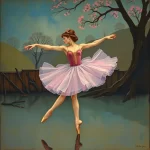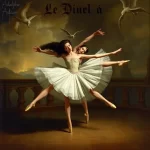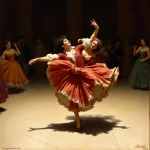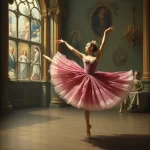Ballet: L’Après-midi d’un Faune (Afternoon of a Faun) (Claude Debussy, 1912)

Introduction
Ballet: L’Après-midi d’un Faune (Afternoon of a Faun) is a seminal work in the history of ballet, choreographed by the legendary Vaslav Nijinsky and set to the music of Claude Debussy. Premiering on May 29, 1912, at the Théâtre du Châtelet in Paris, this one-act ballet is inspired by the poem “L’Après-midi d’un Faune” by Stéphane Mallarmé. The ballet explores the sensual and dreamlike encounter between a faun and a group of nymphs, capturing the essence of Symbolist art and music.
Historical Background
Creation and Development
The early 20th century was a period of significant artistic experimentation and innovation. The Ballets Russes, founded by Sergei Diaghilev, was at the forefront of this movement, bringing together some of the most talented artists, composers, and choreographers of the time. L’Après-midi d’un Faune was created in this vibrant context, reflecting the era’s fascination with myth, nature, and the subconscious.
The ballet was inspired by Stéphane Mallarmé’s 1876 poem, which itself was a reflection of the Symbolist movement in literature. Mallarmé’s work, characterized by its evocative and ambiguous imagery, provided a rich source of inspiration for both Nijinsky and Debussy. The collaboration between Nijinsky, Debussy, and Diaghilev was crucial in bringing this ballet to life, with each artist contributing their unique vision and expertise.
Premiere and Reception
L’Après-midi d’un Faune premiered on May 29, 1912, at the Théâtre du Châtelet in Paris. The initial reception was mixed, with some critics praising the innovative choreography and others finding it controversial. The ballet’s sensuality and Nijinsky’s unconventional movements challenged traditional ballet norms, leading to both admiration and scandal. Despite the mixed reviews, the ballet quickly gained recognition and became a significant work in the Ballets Russes repertoire.
Synopsis of the Ballet
L’Après-midi d’un Faune is a one-act ballet that unfolds in a single, continuous scene. The plot is simple yet evocative, focusing on the faun’s encounter with a group of nymphs in a sun-drenched glade.
The ballet opens with the faun lounging on a rock, playing his flute. He is soon captivated by the appearance of several nymphs, who dance and frolic around him. The faun attempts to interact with them, but they remain elusive. One nymph leaves behind her scarf, which the faun seizes and passionately embraces. The ballet concludes with the faun lying down with the scarf, lost in a dreamlike reverie.
Musical Composition
Composer’s Role
Claude Debussy, one of the most influential composers of the early 20th century, composed the music for L’Après-midi d’un Faune. Debussy’s score, originally written as a symphonic poem in 1894, is a masterpiece of Impressionist music. His use of lush harmonies, delicate orchestration, and evocative melodies perfectly complements the ballet’s ethereal and sensual atmosphere.
Musical Themes and Motifs
The music of L’Après-midi d’un Faune is characterized by its fluid, dreamlike quality. Debussy employs recurring musical themes and motifs to enhance the narrative and emotional depth of the ballet. The opening flute solo, one of the most famous passages in classical music, sets the tone for the entire piece, evoking the faun’s languid and contemplative state. Throughout the ballet, Debussy’s music mirrors the faun’s shifting emotions, from curiosity and desire to introspection and longing.
Famous Recordings and Performances
There have been numerous recordings of Debussy’s score for L’Après-midi d’un Faune, performed by some of the world’s leading orchestras and conductors. Notable recordings include those by the Berlin Philharmonic conducted by Herbert von Karajan and the Boston Symphony Orchestra conducted by Seiji Ozawa. These recordings capture the exquisite beauty and subtlety of Debussy’s music, making them essential listening for any ballet enthusiast.
Choreography and Dance
Choreographer’s Vision
Vaslav Nijinsky’s choreography for L’Après-midi d’un Faune was groundbreaking in its departure from traditional ballet techniques. Nijinsky’s vision was to create a dance that reflected the natural, primal essence of the faun and nymphs. He drew inspiration from ancient Greek art, particularly vase paintings, which influenced the ballet’s stylized, two-dimensional movements. Nijinsky’s choreography emphasized angular poses, fluid transitions, and a sense of stillness, creating a unique and mesmerizing visual experience.
Signature Dance Numbers
The ballet’s most iconic dance number is the faun’s solo, which showcases Nijinsky’s innovative choreography and expressive power. This solo captures the faun’s curiosity and desire as he interacts with the nymphs and ultimately embraces the scarf. The nymphs’ group dances are also significant, highlighting their ethereal and elusive nature. These dances are characterized by graceful, flowing movements that contrast with the faun’s more grounded and angular gestures.
Notable Interpretations
Over the years, L’Après-midi d’un Faune has been interpreted and adapted by various choreographers and dance companies. Each production brings its unique perspective to the ballet, reflecting contemporary artistic trends and sensibilities. Notable interpretations include those by Rudolf Nureyev, who brought a more dramatic and intense approach to the faun’s character, and Jerome Robbins, who created a modern, minimalist version for the New York City Ballet.
Characters and Roles
Main Characters
The primary character in L’Après-midi d’un Faune is the faun, a mythical creature who embodies both human and animal qualities. The faun is curious, sensual, and introspective, reflecting the complex interplay between desire and contemplation. His interactions with the nymphs drive the ballet’s narrative and emotional arc.
Supporting Characters
The nymphs are the secondary characters in the ballet, representing ethereal and elusive feminine beauty. They are playful and mysterious, captivating the faun with their grace and allure. While their roles are less defined than the faun’s, they are essential in creating the ballet’s dreamlike and sensual atmosphere.
Famous Dancers
Several renowned dancers have portrayed the faun and nymphs in L’Après-midi d’un Faune. Vaslav Nijinsky, the original faun, remains the most iconic performer of the role. Other notable dancers include Rudolf Nureyev, Mikhail Baryshnikov, and Roberto Bolle, each bringing their unique interpretation to the character. Famous nymphs include Tamara Karsavina, who danced in the original production, and more recently, dancers like Sylvie Guillem and Diana Vishneva.
Cultural and Artistic Impact
Influence on Ballet and Dance
L’Après-midi d’un Faune has had a profound influence on the development of ballet and modern dance. Nijinsky’s innovative choreography challenged traditional ballet norms and paved the way for more experimental and expressive forms of dance. The ballet’s emphasis on natural, primal movements and its integration of music, dance, and visual art have inspired countless choreographers and dancers.
Cultural Significance
The ballet’s cultural significance extends beyond the world of dance. It has been referenced and adapted in various forms of art, literature, and media. The ballet’s themes of desire, nature, and the subconscious resonate with broader cultural and artistic movements, making it a timeless and enduring work.
Legacy and Revivals
L’Après-midi d’un Faune continues to be performed and celebrated today, with major revivals and reinterpretations by leading dance companies worldwide. The ballet’s legacy is evident in its enduring popularity and its influence on contemporary dance and choreography. Modern adaptations often explore new interpretations of the faun’s character and the ballet’s themes, ensuring that L’Après-midi d’un Faune remains a vital and relevant work.
Iconic Productions
Historic Productions
The original 1912 production of L’Après-midi d’un Faune by the Ballets Russes is one of the most famous historical productions. Key figures involved in this production included Vaslav Nijinsky as the faun, Tamara Karsavina as one of the nymphs, and Léon Bakst as the set and costume designer. This production set the standard for future interpretations and remains a landmark in the history of ballet.
Contemporary Productions
Recent productions of L’Après-midi d’un Faune have brought new perspectives and innovations to the ballet. Companies like the Paris Opera Ballet, the Royal Ballet, and the New York City Ballet have staged contemporary versions that explore different aspects of the faun’s character and the ballet’s themes. These productions often incorporate modern set and costume designs, as well as new choreographic elements, while staying true to the spirit of the original work.
Production Design
The set, costume, and lighting design play a crucial role in creating the dreamlike and sensual atmosphere of L’Après-midi d’un Faune. Léon Bakst’s original designs for the Ballets Russes production were highly influential, featuring vibrant colors, intricate patterns, and a stylized, two-dimensional aesthetic. Contemporary productions often draw inspiration from Bakst’s designs while incorporating modern elements to enhance the visual impact of the ballet.
Critical Reception and Reviews
Initial Critical Response
The initial critical response to L’Après-midi d’un Faune was mixed, with some critics praising the ballet’s innovation and others finding it controversial. The ballet’s sensuality and Nijinsky’s unconventional movements challenged traditional ballet norms, leading to both admiration and scandal. Despite the mixed reviews, the ballet quickly gained recognition and became a significant work in the Ballets Russes repertoire.
Modern Reviews
Contemporary critics and audiences generally view L’Après-midi d’un Faune as a groundbreaking and influential work. The ballet is praised for its innovative choreography, evocative music, and timeless themes. Modern reviews often highlight the ballet’s enduring relevance and its impact on the development of dance and choreography. The ballet’s ability to captivate and inspire new generations of dancers and audiences is a testament to its lasting significance.
Fun Facts and Trivia
Behind-the-Scenes Stories
One interesting behind-the-scenes story involves the controversy surrounding Nijinsky’s final pose in the ballet, where he lies down with the nymph’s scarf. Some critics and audience members found this pose too suggestive, leading to scandal and debate. Despite the controversy, this pose has become one of the most iconic images in ballet history.
Notable Performers
Several famous dancers have portrayed the faun and nymphs in L’Après-midi d’un Faune. Vaslav Nijinsky, the original faun, remains the most iconic performer of the role. Other notable dancers include Rudolf Nureyev, Mikhail Baryshnikov, and Roberto Bolle, each bringing their unique interpretation to the character. Famous nymphs include Tamara Karsavina, who danced in the original production, and more recently, dancers like Sylvie Guillem and Diana Vishneva.
Trivia
- The original score for L’Après-midi d’un Faune was composed by Claude Debussy in 1894 as a symphonic poem, long before it was adapted for the ballet.
- Nijinsky’s choreography for the ballet was influenced by ancient Greek art, particularly vase paintings, which inspired the ballet’s stylized, two-dimensional movements.
- The ballet’s premiere in 1912 was part of a larger program by the Ballets Russes, which also included works by other prominent composers and choreographers.
Conclusion
Summary of the Ballet’s Importance
L’Après-midi d’un Faune is a landmark work in the history of ballet, known for its innovative choreography, evocative music, and timeless themes. The collaboration between Vaslav Nijinsky, Claude Debussy, and Sergei Diaghilev resulted in a ballet that challenged traditional norms and paved the way for more experimental and expressive forms of dance. The ballet’s influence on the development of ballet and modern dance is profound, making it a significant work in the world of dance.
Final Thoughts
L’Après-midi d’un Faune remains a captivating and inspiring work that continues to resonate with audiences and dancers alike. Its exploration of desire, nature, and the subconscious, combined with its innovative choreography and music, make it a timeless and enduring ballet. Whether you are a seasoned ballet enthusiast or new to the world of dance, L’Après-midi d’un Faune is a must-see performance that offers a unique and mesmerizing experience.
FAQ
What is the central theme of this ballet?
The central theme of L’Après-midi d’un Faune is the exploration of desire, nature, and the subconscious, as depicted through the faun’s encounter with a group of nymphs.
Who are the main characters in this ballet?
The main characters in the ballet are the faun, a mythical creature who embodies both human and animal qualities, and the nymphs, who represent ethereal and elusive feminine beauty.
What is the most famous dance number in this ballet?
The most famous dance number in L’Après-midi d’un Faune is the faun’s solo, which showcases Nijinsky’s innovative choreography and expressive power.
How long does a typical performance of this ballet last?
A typical performance of L’Après-midi d’un Faune lasts approximately 10 to 12 minutes, as it is a one-act ballet.
Are there any modern adaptations of this ballet?
Yes, there have been numerous modern adaptations of L’Après-midi d’un Faune by various choreographers and dance companies, each bringing their unique perspective to the ballet.
Why is this ballet considered important in the history of dance?
L’Après-midi d’un Faune is considered important in the history of dance due to its innovative choreography, evocative music, and its influence on the development of ballet and modern dance. The ballet challenged traditional norms and paved the way for more experimental and expressive forms of dance.





